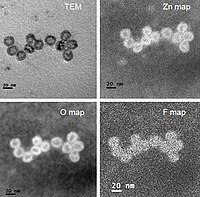
Photo from wikipedia
Abstract Significantly increased efficiency in quantum dot light emitting diodes (QLEDs) has been realized by inserting a thin interlayer of 1,3,5-tris(N-phenylbenzimidazole-2-yl)benzene (TPBi, 3 nm) between CuInS2/ZnS emission layer and 4,4-N,N-dicarbazole-biphenyl (CBP)… Click to show full abstract
Abstract Significantly increased efficiency in quantum dot light emitting diodes (QLEDs) has been realized by inserting a thin interlayer of 1,3,5-tris(N-phenylbenzimidazole-2-yl)benzene (TPBi, 3 nm) between CuInS2/ZnS emission layer and 4,4-N,N-dicarbazole-biphenyl (CBP) hole transport layer (HTL). The maximum current efficiency of 6.2 cd/A is achieved. Our results reveal that there should be two mainly roles for TPBi blocking layer in enhancing the device performance: (i) separating the hole accumulation interface from the exciton formation zone, which prevents the quenching processes of QD emission caused by these accumulated holes, (ii) suppressing the hole leakage from QDs to ZnO. In addition, the influence of QD layer thickness on the device performance is also studied. The QLED with a thinner QD layer possesses higher luminance but lower efficiency, which is due to the changes of electron carrier distribution in the QD layers. High-performance QLEDs can be achieved by controlling the injection and distribution of charge carriers.
Journal Title: Journal of Luminescence
Year Published: 2018
Link to full text (if available)
Share on Social Media: Sign Up to like & get
recommendations!